Hi team!
I have graciously accepted Hilton’s suggestions and here is my revised definition of ‘cognitive dissonance.’ Enjoy your evening.
Best,
Claire
Introduction
Criteria
The outline of this assignment is to choose a fairly complex word and apply three types of definitions to it: a parenthetical definition, a sentence definition, and an expanded definition. Each definition will vary in the level of detail provided. For this assignment we are providing definitions to a ‘nontechnical’ audience.
Objective
In technical writing, adjusting the information we provide in a definition is based on who our intended audience is. It is important to appreciate the different degrees of knowledge people have about a term and recognize when we may need to explain a technical term at length.
Term
Cognitive Dissonance
Situation
A psychologist explaining to a client who is unaware of what cognitive dissonance is.
Parenthetical Definition
We experience cognitive dissonance (a lack of harmony between mind and behaviour) when we perform an action that our thoughts do not approve of.
Sentence Definition
Cognitive dissonance is a theory of experiencing psychological stress when opinions, ideas, or values are inconsistent with a behavioural outcome. Relieving distress can be attempted by changing the behaviour or changing the belief to achieve consistency, or selectively choosing new information and ideas (Festinger, 1962).
Expanded Definition
What is cognitive dissonance?
If you have ever experienced a situation when you believe in something and your actions do not align with that belief, it is likely you have experienced cognitive dissonance. There is a discomfort in these inconsistencies that is natural for us to attempt to correct.
What cognitive dissonance is not
Cognitive dissonance is the opposite of cognitive consonance. Cognitive consonance is when there is compatibility between a person’s thoughts, beliefs, attitudes and actions. Those who experience cognitive dissonance aim to achieve cognitive consonance.
How to overcome cognitive dissonance
There are several ways one can attempt to overcome cognitive dissonance:
- Change your actions
- Admitting and accepting that you have failed in your ideal actions can make it easier to move forward.
- Write out why you should change your behaviour
- Take action to change. Begin with small changes rather than drastic ones. Changing a lot at once can be too overwhelming to want to attempt.
- Ask for support.
- Challenge what you believe in
- Find out which behaviours are conflicting with what you believe in.
- Identify what you value and whether or not you may be influenced by social pressures or who you surround yourself with.
- Accept that what you believe in may be wrong. It can be difficult to question a long-standing belief, and it is also okay to be wrong.
- Reframe your belief in a way that works for you.
- Accept what you choose to do
- Learn more about both sides of your conflict and determine which you want to change
- Seek a counsellor if you need help
- Make a pros and cons list. Focus the your pros list for what you choose, and elaborate on the cons of the alternative that you chose not to go with
- Try not to question the decision you made
What is cognitive dissonance in a real situation?
When a smoker knows smoking is bad for your health, he experiences cognitive dissonance. As a result, he might try to quit (change in action), he might try to believe that health experts are lying and it is not as bad for your health as they make it seem (change in belief), or he might justify his habit by obtaining new knowledge that “smoking keeps your weight down” (change in perception of action).
History
In 1957, social psychologist Leon Festinger released a book called A Theory of Cognitive Dissonance. He suggested that when a person has conflicting attitudes and experiences they encounter a great deal of distress. Festinger’s hypothesis was based on the ideas that (1), inconsistency and feeling uncomfortable motivates a person to try and reduce dissonance and achieve consistency, and (2), when inconsistencies between the mind and behaviours are present, a person will avoid situations and information that could lead to more inconsistencies (Festinger, 1957).
Figure 1

The Cognitive Dissonance Theory
Figure 1 shows a laid out model of the Cognitive Dissonance. The incongruence of our belief and action leads to an increasing dissonance. We then make a decision to either change our belief, change our action, or change how we perceive our action. This can lead to a decrease in dissonance.
References
Festinger, L. (1957). A Theory of Cognitive Dissonance. Stanford University Press.
Festinger, L. (1962). Cognitive dissonance. Scientific American. 207(4), 93-106. doi:10.1038/scientificamerican1062-93
Figure 1. The Cognitive Dissonance Theory. Reprinted from 3 Tips To Apply The Cognitive Dissonance Theory in eLearning, by Christopher Pappas, July 22 2016, retrieved from https://cdn.elearningindustry.com/wp-content/uploads/2016/07/apply-cognitive-dissonance-theory-elearning.jpeg.
Leave a Reply